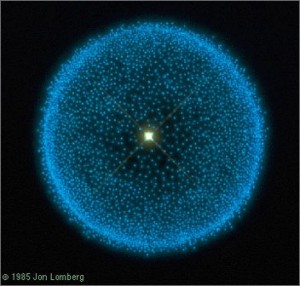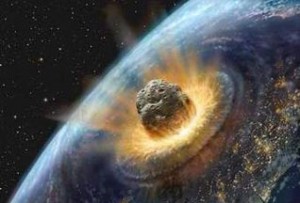Death Star Theory Doomed
by Louis Zbinden | December 04, 2012 3:15 PM
Well, it turns out that the Death Star didn’t wipe out the dinosaurs. And no, I’m not talking about Star Wars and Darth Vader. Up until recently, the Nemesis theory of extinction still held some merit. However, a recent study by scientists has found that the Death Star concept will remain science fiction for now.
 What is Nemesis? During the 1980s, geologists found what appeared to be a cycle of mass extinction that repeated approximately every 26 million years. However, no one knew what was causing these extinctions on such a regular schedule. In response to this discovery, scientists developed the theory that a star in wide orbit of our sun (1.5 light-years to be precise) could be causing these extinctions. This star was given the nickname Nemesis. During a certain point in its orbit, Nemesis would pass through the Oort cloud. This “cloud” is like a giant bubble of asteroids and comets that exists about 1 light year away from the sun. As Nemesis passes through this area in space, its gravity would disrupt some of the comets and sling them in every direction. The Nemesis theory claims that some of these comets would be directed towards the inner solar system and eventually collide with Earth. These impacts would cause worldwide catastrophe and wipe out a significant amount life on the planet (RIP dinosaurs.)
What is Nemesis? During the 1980s, geologists found what appeared to be a cycle of mass extinction that repeated approximately every 26 million years. However, no one knew what was causing these extinctions on such a regular schedule. In response to this discovery, scientists developed the theory that a star in wide orbit of our sun (1.5 light-years to be precise) could be causing these extinctions. This star was given the nickname Nemesis. During a certain point in its orbit, Nemesis would pass through the Oort cloud. This “cloud” is like a giant bubble of asteroids and comets that exists about 1 light year away from the sun. As Nemesis passes through this area in space, its gravity would disrupt some of the comets and sling them in every direction. The Nemesis theory claims that some of these comets would be directed towards the inner solar system and eventually collide with Earth. These impacts would cause worldwide catastrophe and wipe out a significant amount life on the planet (RIP dinosaurs.)
Shouldn’t We Be Worried?
Luckily, we need not be worried about being wiped out by comets anytime soon. Even if the Nemesis theory is true, the last impact happened about 11 million years ago. This gives us 15 million years to come up with some sort of survival plan. However, a recent review of the Nemesis theory done by Melott and Bambach assures us that such a back-up plan won’t be necessary.
Trouble with Nemesis
 There are many problems associated with the Nemesis theory. One primary objection is that if there were another star this close to our sun, wouldn’t we have seen it by now? One explanation to this objection is that Nemesis may be a dwarf star. Dwarf stars, as their name implies, are smaller than normal stars, and also much dimmer. This would make Nemesis much harder to notice. However, scientists have been able to discover over one thousands dwarf but none of them are in our solar system. The biggest problem, according to the study, is that the nice and tidy period of 26 million years might just be too good to be true. If the orbit of a star such as Nemesis were truly causing these extinctions that have been measured on Earth, they wouldn’t be so punctual. That’s right, for once, a theory is too precise for it’s data, and not the other way around. On a scale as large as the one involved in the Nemesis, there are bound to be some complications. The major problem cited by the review was that of Nemesis’s period. Even if Nemesis were able to throw comets a light-year away precisely enough to hit Earth, this would not happen with the consistency needed to explain the extinction pattern. As Nemesis orbits our sun, there are countless other objects, including other stars, that would tug Nemesis off of its current orbit, changing the length of time it would take to orbit the sun.
There are many problems associated with the Nemesis theory. One primary objection is that if there were another star this close to our sun, wouldn’t we have seen it by now? One explanation to this objection is that Nemesis may be a dwarf star. Dwarf stars, as their name implies, are smaller than normal stars, and also much dimmer. This would make Nemesis much harder to notice. However, scientists have been able to discover over one thousands dwarf but none of them are in our solar system. The biggest problem, according to the study, is that the nice and tidy period of 26 million years might just be too good to be true. If the orbit of a star such as Nemesis were truly causing these extinctions that have been measured on Earth, they wouldn’t be so punctual. That’s right, for once, a theory is too precise for it’s data, and not the other way around. On a scale as large as the one involved in the Nemesis, there are bound to be some complications. The major problem cited by the review was that of Nemesis’s period. Even if Nemesis were able to throw comets a light-year away precisely enough to hit Earth, this would not happen with the consistency needed to explain the extinction pattern. As Nemesis orbits our sun, there are countless other objects, including other stars, that would tug Nemesis off of its current orbit, changing the length of time it would take to orbit the sun.
But what does it mean?
So it seems that we won’t need Luke Skywalker or Han Solo to deal with this Death Star for us:  science has taken care of that for us. As Merlott and Bambach state in their study, “Fossil data, which motivated the idea of Nemesis, now militate against it.” So it would seem that the idea of Nemesis being the cause of the regular pattern of extinctions of Earth is on shaky ground at best. But to everyone out there who were holding on to the hope that there might just be a real life “Death Star” out there, don’t give up hope If the theory of a dark star throwing comets through space from over a light year away isn’t the answer to the mysterious repetition of extinctions Earth has witnessed, then this leaves the door open for other, perhaps even stranger theories. Surely anything that causes enough destruction to wipe out billions of animals on a precise schedule of 26 million years must be stranger than fiction. Hey, perhaps instead of a boring old regular star killing off the dinosaurs and other life every few million years, it could be aliens, or even a real Star Wars-esque Death Star.
science has taken care of that for us. As Merlott and Bambach state in their study, “Fossil data, which motivated the idea of Nemesis, now militate against it.” So it would seem that the idea of Nemesis being the cause of the regular pattern of extinctions of Earth is on shaky ground at best. But to everyone out there who were holding on to the hope that there might just be a real life “Death Star” out there, don’t give up hope If the theory of a dark star throwing comets through space from over a light year away isn’t the answer to the mysterious repetition of extinctions Earth has witnessed, then this leaves the door open for other, perhaps even stranger theories. Surely anything that causes enough destruction to wipe out billions of animals on a precise schedule of 26 million years must be stranger than fiction. Hey, perhaps instead of a boring old regular star killing off the dinosaurs and other life every few million years, it could be aliens, or even a real Star Wars-esque Death Star.
Further Reading
A Death Star Named Nemesis Isn’t to Blame for Mass Extinctions
Nemesis No More? Comet-Hurling ‘Death Star’ Most Likely a Myth
Nemesis death star theory that it hurls comets towards Earth is debunked by scientists
Reference
Merlott, Adrian L., and Richard K. Bambach. “Nemesis Reconsidered.” Monthly Notices of the Royal Astronomical Society: Letters 407.1 (2010): L99-102. <http://onlinelibrary.wiley.com/doi/10.1111/j.1745-3933.2010.00913.x/full>
Original Article
